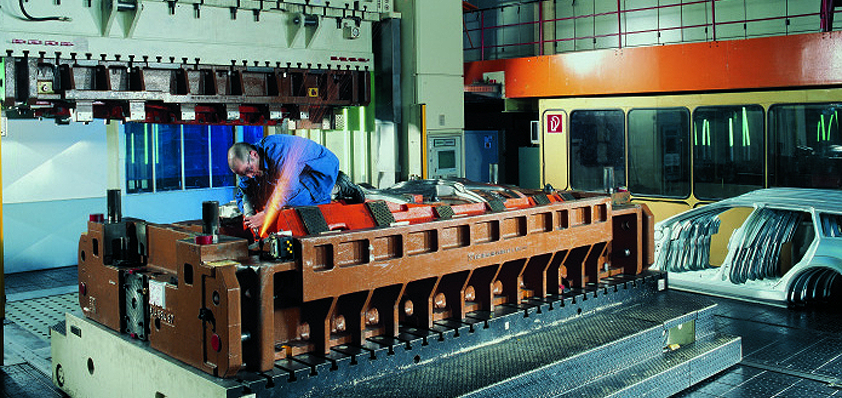
AutoForm Engineering USA
Imagine that tryout personnel at a press are having issues with manufacturing their stamped panel. Rather than review a digital simulation, they just begin to make changes to the tool. “Some of those changes are irreversible,” Matt Kruithoff, senior application engineer at AutoForm Engineering USA Inc., says about this scenario.
“They might resolve one issue only to cause another problem.” AutoForm-TryoutAssistant, a product of AutoForm Engineering, acts as a digital assistant during the tryout of dies. TryoutAssistant allows tryout personnel to take into account what was previously done by simulation engineers and interactively shows what will happen to the panel if changes are made to the die. Via a computer or tablet, tryout personnel can use AutoForm-TryoutAssistant to determine what doesn’t match between the simulation and the panel produced from the actual die, such as material thickness, blank size, lubrication or other factors.
“AutoForm-TryoutAssistant provides stamping experts with the checks and balances before they go in to tryout,” Kruithoff says. “Was the tool machined correctly and were the right materials and lubrication used?”
In the past, companies went from product development directly into the manufacturing of a tool which sometimes resulted in difficulties. Simulation, in contrast, first goes through the steps to prove-out the process, then moves forward to design for build and finally finishes at tryout. “All three of those areas need to communicate with each other,” Kruithoff says. “If there is a breach in communication, then that is usually where you end up having problems. I have seen this breach in communication from working in the industry.”
Kruithoff adds that the data is recorded. “We have had these problems, let’s adjust for this up front and avoid these problems in the future,” he explains.
AutoForm-TryoutAssistant can be useful to suppliers and also OEMs. “If they have to request a product change, they can show this is what we tried and these are the areas that did not work,” Kruithoff says. “This digital proof gives them more leverage for requesting a product change.”
AutoForm-TryoutAssistant’s interface is easy for tryout personnel on the shop floor to use, which saves time and money. “Press time is very limited and very expensive,” Kruithoff notes. “AutoForm-TryoutAssistant allows you to match the simulation without needing to rethink the entire process. I’m excited about this new module. I would have liked to have seen it 15 years ago.”
Closing the Loop
AutoForm provides software that simulates the client’s metal stamping processes to make sure that their process is feasible. AutoForm software is compatible with many CAD systems, Kruithoff says.
“[AutoForm] actually closes the loop from the front end of product development all the way through production,” Kruithoff points out. “You can import a part, design the engineered process and run it through to the Tryout stage without ever leaving the interface of AutoForm.”
“We provide much more than just simulating the process,” Technical Account Manager Mark Hineline explains. “Using AutoForm, our customers can bring a complete proven process into CAD or they can import their CAD process into AutoForm to validate the design.”
Also, as simulation has become more accurate, prototyping is done less often. “When we were in the die shops 20 to 30 years ago, almost every part had a prototype,” Hineline notes. “Due to the shortened timeframe to develop an automobile and put it into production, there is less time for prototypes, nor is it necessary when utilizing AutoForm’s advancements.”
“It used to take 16 to 48 weeks to build a tool, depending on the size,” Kruithoff says. “Now the equivalent tool timing has been cut down to half of that by removing the trial and error. Our software is quick to solve or avoid problems in processes with high accuracy. You can get much more work done with AutoForm.”
Hineline agrees: “The better we become, the more customers depend on us and request us to fulfill their needs.”
AutoForm recommends using its simulation software as early as possible in the design process. “If it is done early enough, you can easily make changes,” Hineline explains. “If you discover a part doesn’t fit into the assembly and you have to change the assembly, that becomes very expensive.”
About AutoForm
AutoForm Engineering was founded in 1995 in Zurich, Switzerland. Today, more than 3,500 users in more than 1,000 companies in 50 countries use AutoForm. The U.S. locations of AutoForm are in Troy and Grand Rapids, Michigan, and near Columbus, Ohio.
The company primarily works with OEMs and stamping suppliers in the automotive sector, and also includes customers in the medical, aerospace, farm and lawn equipment, and appliance segments.
AutoForm’s strengths reside in the software’s speed, accuracy, and technical support. As the future of stamping processes evolve and the time between product development and production shrinks, likewise AutoForm evolves its software.
The Zurich and Dortmund offices develop the software. Outside Zurich, technical support makes up the largest portion of the company. That includes training, online support and call-in technical support. “AutoForm supports their customers very well,” Kruithoff says.
Many of the people handling AutoForm’s technical support have held long careers in the metal stamping industry. Hineline, for example, was a journeyman die maker who later went into design. “We know what we are talking about,” he says. “We know what we are recommending and what the customer is feeling. We talk the same language.”